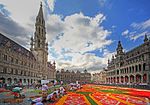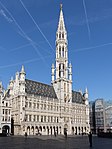1979 Brussels bombing
1979 crimes in BelgiumAugust 1979 events in EuropeBritish military bandsImprovised explosive device bombings in 1979Improvised explosive device bombings in Belgium ... and 5 more
Provisional IRA bombings in continental EuropeTerrorist incidents in BelgiumTerrorist incidents in Belgium in the 1970sTerrorist incidents in BrusselsTerrorist incidents in Europe in 1979

The 1979 Brussels bombing was an attack carried out by volunteers belonging to the Provisional Irish Republican Army (IRA) against a British Army band on the Grand Place, the central square of Brussels in Belgium on 28 August 1979. The bombing injured seven bandsmen and eleven civilians, and caused extensive damage.
Excerpt from the Wikipedia article 1979 Brussels bombing (License: CC BY-SA 3.0, Authors, Images).1979 Brussels bombing
Grand Place, City of Brussels Pentagon (Brussels)
Geographical coordinates (GPS) Address Nearby Places Show on map
Geographical coordinates (GPS)
| Latitude | Longitude |
|---|---|
| N 50.846666666667 ° | E 4.3525 ° |
Address
Grand-Place - Grote Markt
Grand Place
1000 City of Brussels, Pentagon (Brussels)
Belgium
Open on Google Maps











